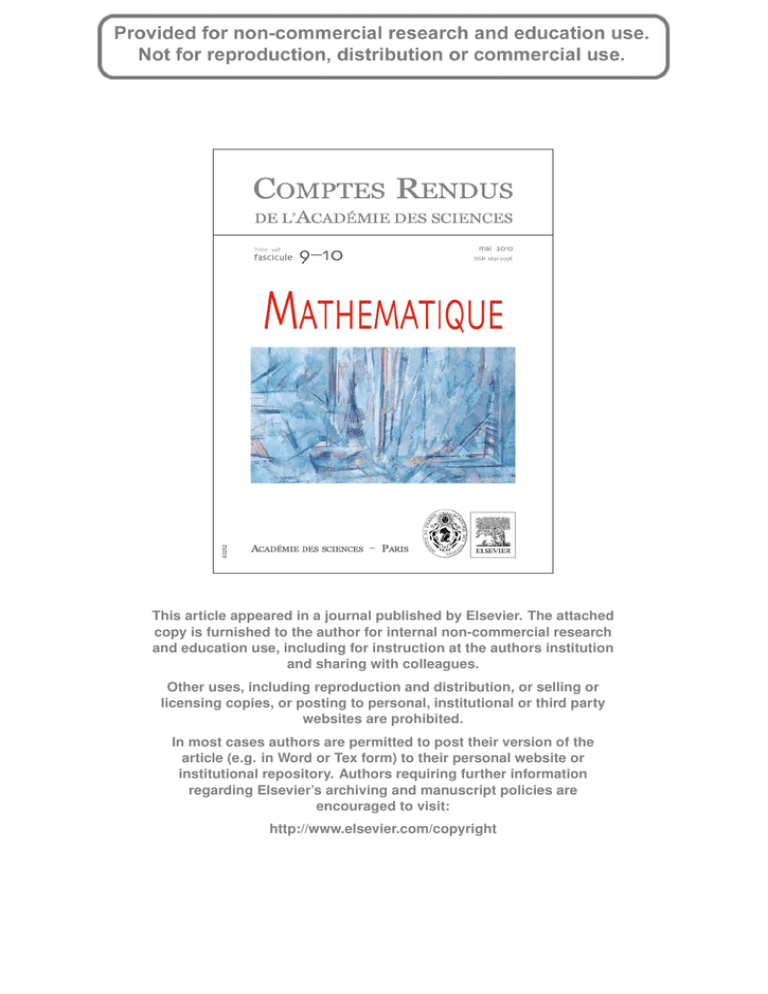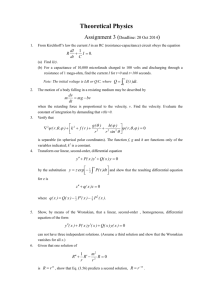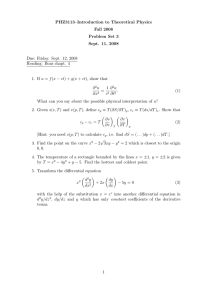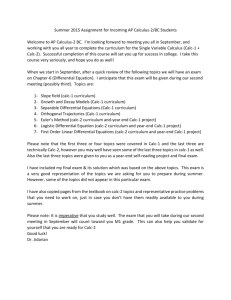
This article appeared in a journal published by Elsevier. The attached
copy is furnished to the author for internal non-commercial research
and education use, including for instruction at the authors institution
and sharing with colleagues.
Other uses, including reproduction and distribution, or selling or
licensing copies, or posting to personal, institutional or third party
websites are prohibited.
In most cases authors are permitted to post their version of the
article (e.g. in Word or Tex form) to their personal website or
institutional repository. Authors requiring further information
regarding Elsevier’s archiving and manuscript policies are
encouraged to visit:
http://www.elsevier.com/copyright
Author's personal copy
C. R. Acad. Sci. Paris, Ser. I 348 (2010) 487–490
Contents lists available at ScienceDirect
C. R. Acad. Sci. Paris, Ser. I
www.sciencedirect.com
Algebra/Ordinary Differential Equations
Differential ‘Galois’ extensions with new constants
Extensions différentielles « galoisiennes » avec nouvelles constantes
Lourdes Juan a , Andy R. Magid b
a
b
Department of Mathematics, Texas Tech University, Lubbock, TX 79409, United States
Department of Mathematics, University of Oklahoma, Norman, OK 73019, United States
a r t i c l e
i n f o
a b s t r a c t
Article history:
Received 12 February 2009
Accepted after revision 6 April 2010
Presented by Bernard Malgrange
Let F be a differential field with algebraically closed field of constants C and let E
be a differential field extension of F . The field E is a differential Galois extension if
it is generated over F by a full set of solutions of a linear homogeneous differential
equation with coefficients in F and if its field of constants coincides with C . We study
the differential field extensions of F that satisfy the first condition but not the second.
© 2010 Académie des sciences. Published by Elsevier Masson SAS. All rights reserved.
r é s u m é
Soit F un corps différentiel dont le corps des constantes C est algébriquement clos et
soit E ⊃ F une extension de corps différentiels. Le corps différentiel E est une extension
galoisienne différentielle de F s’il est engendré sur F par une base de solutions d’une
équation différentielle linéaire homogène à coefficients dans F et si son corps des
constantes est C . Nous étudions les extensions différentielles de F qui satisfont la première
condition et non la seconde.
© 2010 Académie des sciences. Published by Elsevier Masson SAS. All rights reserved.
1. Introduction
Let F be a differential field of characteristic zero. Let C denote the field of constants of F (assumed algebraically closed).
Let L = Y (n) + a1 Y (n−1) + · · · + a0 Y be a linear differential operator over F .
A Picard–Vessiot, or differential Galois, extension E of F for L is a differential field extension, also with field of constants
C (i.e. a no new constant extension), generated over F as a differential field by n solutions of L = 0 linearly independent
over C (i.e. a full set of solutions). The differential Galois group G ( E / F ) is the group of differential field automorphisms of E
fixing F , and the resulting Galois correspondence includes the fact that the fixed field of E under G ( E / F ) is F . The same
extension E is a Picard–Vessiot extension of F for many different operators L. One way to suppress the explicit reference
to a specific operator is to note that a differential field extension E ⊃ F is a Picard–Vessiot extension for some operator L
provided that
(1) There is a group G of differential automorphisms of E over F whose fixed field is F .
(2) E is generated over F as a differential field by a G-submodule V which is finite dimensional over C .
(3) E is a no new constant extension of F .
E-mail addresses: lourdes.juan@ttu.edu (L. Juan), amagid@math.ou.edu (A.R. Magid).
1631-073X/$ – see front matter
doi:10.1016/j.crma.2010.04.004
©
2010 Académie des sciences. Published by Elsevier Masson SAS. All rights reserved.
Author's personal copy
488
L. Juan, A.R. Magid / C. R. Acad. Sci. Paris, Ser. I 348 (2010) 487–490
The operator L for which E is Picard–Vessiot is produced from V using Wronskian determinants, and then V has a full set
of solutions of L as a C -basis (see [2]).
There are natural situations, however, for example the case of certain derivations on coordinate rings of connected
algebraic groups, which lead to extensions E ⊃ F which meet the first two criteria but not the third. Such extensions are
our subject here.
We reformulate the situation in terms of rings generated by solutions.
The ring F [ y i j : 1 i n, 0 j n − 1][ w −1 ], where w = det( y i j ), with derivation y i j = y i , j +1 , y i ,n−1 = −an−1 y i ,n−1 −
· · · − a0 y i0 contains and is differentially generated by n solutions y i0 to the differential equation L = 0 whose Wronskian is
a unit, and the same remains true for its homomorphic images. (This is why it is called a full universal solution algebra for
L in [2].) If we take a maximal differential ideal of the full universal solution algebra and mod it out, the quotient field of
the resulting integral domain is a Picard–Vessiot extension of F for L: it has the additional property that its constants are
C as well. It doesn’t matter which maximal differential ideal we choose: all are conjugate under the (differential) action of
GLn (C ) extended from the linear action on the y i j [2]. And the stabilizer in GLn (C ) of the chosen maximal ideal, which acts
naturally mod it and on the quotient field, is the group of all differential automorphisms and the differential Galois group
over F .
We focus on what happens when a not necessarily maximal prime differential ideal P of the full universal solution
algebra is selected, modded out, and we consider the resulting quotient field extension E of F . When the prime ideal is not
maximal, the constant field K of E is a proper extension of F , and of course need not be algebraically closed. Our main
result shows that nonetheless E is much like a Picard–Vessiot extension of the compositum field F K . In particular, we find
an algebraic subgroup G of GLn ( K ) with E G = F K .
Unless (0) is a maximal differential ideal of the full universal solution algebra, the latter will always have non-maximal
prime differential ideals to which our results apply. A typical situation to which our results apply is the following: Let
H be a connected
algebraic group over C , let D 1 , . . . , D m be a basis of Lie( H ), let bi ∈ F and consider the derivation
D = D F ⊗ 1 + b i ⊗ D i on F [ H ] = F ⊗ C [ H ]. We show that there is an operator L as above which has a full set of solutions
in F ( H ) (the quotient field of F [ H ]) with invertible Wronskian, so that the algebra they differentially generate over F fits
into our theory above. The appropriate consequences are drawn.
We will preserve throughout the notational conventions of this introduction. Another useful reference on the Picard–
Vessiot theory is [3].
2. Modulo non-maximal primes
Let P be a prime differential ideal of the full universal solution algebra F [ y i j : 1 i n, 0 j n − 1][ w −1 ] for L =
Y (n) + a1 Y (n−1) + · · · + a0 Y , let R F denote F [ y i j ][ w −1 ], and let E denote the quotient field of R F / P . Let K denote the field
of constants of E. We choose an algebraic closure E of E. Then K , the algebraic closure of K in E, is also algebraically closed
and is the field of constants of the composita E K and F K . To see that K is indeed the field of constants, we use the fact
that E K ⊇ E is an algebraic extension, so that any constant must be algebraic over the constants K of E.
Lemma 1. E K is a Picard–Vessiot extension of F K for L.
Proof. E K is generated over F K by a full set of solutions, with non-zero Wronskian of L = 0, so the only issue is new
constants. As we just noted, the constants of E K are K which is also the constants of F K . 2
Let E 0 be a differential subfield of E containing F and K , for example F K . Then Lemma 1 also implies that E K is a
Picard–Vessiot extension of E 0 K .
Let zi j be the image of y i j in E K . Let R E 0 K = E 0 K ⊗ F R F and consider the homomorphism R E 0 K → E K induced from
y i j → zi j . Let M be its kernel. Note that R E 0 K is also a full universal solution algebra for L over E 0 K . If M were not
maximal then as above the quotient field E K of R E 0 K / M would contain a new constant, a contradiction. So M is a maximal
differential ideal.
Let R E 0 = E 0 ⊗ F R F and let M 0 be the kernel of the homomorphism R E 0 → E induced from y i j → zi j . We have R E 0 K ⊇
R E 0 and M ∩ R E 0 = M 0 .
We note that K ∩ E = K , since anything algebraic over constants is a constant. It follows that K ⊗ K E is an integral
domain, and hence so is K ⊗ K E 0 . Since these are integral domains algebraic over fields, they are themselves fields. Thus
E K = K ⊗ K E and E 0 K = K ⊗ K E 0 .
Lemma 2. E 0 K ∩ E = E 0 .
Proof. From the above equalities, the assertion is the obvious one that ( K ⊗ K E 0 ) ∩ ( K ⊗ K E ) = K ⊗ K E 0 in K ⊗ K E.
These observations allow us to conclude that the ideal M is induced (we use the above notation):
2
Author's personal copy
L. Juan, A.R. Magid / C. R. Acad. Sci. Paris, Ser. I 348 (2010) 487–490
489
Lemma 3. K ⊗ K R E 0 / M 0 is isomorphic to R E 0 K / M as K -algebra. In particular:
(1) M 0 is a maximal differential ideal.
(2) M = R E 0 K M 0 as ideals.
(3) M = K M 0 as K -vector spaces.
Proof. By the discussion preceding the lemma, the subring S = K ⊗ K R E 0 / M 0 of K ⊗ K E can be regarded as a subring of
E K . Viewed in that way, it is the E 0 K algebra generated by zi j and the inverse Wronskian, and that algebra is R E 0 K / M. This
implies the main assertion of the lemma and the others are direct consequences. 2
The rings R E 0 and R E 0 K are generated by the vector spaces V K =
i, j
K y i j and V K =
i, j
K y i j (and the inverse Wron-
skians) over their coefficient fields. Differential actions of the groups GLn ( K ) and GLn ( K ) on R F K and R F K come from their
actions on these vector spaces [2]. The inclusion GLn ( K ) ⊆ GLn ( K ) is compatible with the inclusion V K ⊆ V K . So we can
regard GLn ( K ) as acting on R E 0 K , and the restriction of that action to the subring R E 0 is the given action. The stabilizer
GLn ( K ) M of the ideal M is an algebraic subgroup of GLn ( K ); in fact, it is the differential Galois group G ( E K / E 0 K ) [2].
Lemma 4. The stabilizer GLn ( K ) M 0 of M 0 is Zariski dense in GLn ( K ) M .
Proof. We have by Lemma 3 that M = K M 0 . If M 0 were a finite dimensional K -vector space, the result would be obvious.
Since the actions here are rational, we can reduce immediately to the finite dimensional case and conclude the same
result. 2
We are now ready for the main result.
Theorem 1. Let G ( E / E 0 ) = GLn ( K ) M 0 . Then E G ( E / E 0 ) = E 0 .
Proof. Because G ( E / E 0 ) is Zariski dense in G ( E K / E 0 K ) by Lemma 4, and E K ⊃ E 0 K is Picard–Vessiot by Lemma 1 we have
( E K )G ( E / E 0 ) = E 0 K . It follows that E G ( E / E 0 ) ⊆ E 0 K . So it suffices to show that E ∩ E 0 K = E 0 . This is just Lemma 2. 2
3. Derivations of group coordinate rings
Warning: the symbol E is used in this section differently than above.
Let H be a connected
linear algebraic group over C , let D 1 , . . . , D m be a basis of Lie( H ), let bi ∈ F and consider the
derivation D = D F ⊗ 1 + 1 ⊗ D i on F [ H ] = F ⊗ C [ H ]. We regard H as acting on F [ H ] by left translations (h · f ( g ) = f ( gh))
so that D is H -equivariant. Both D and the H -action extend to the quotient field F ( H ) and commute with each other.
Let W be some finite dimensional C -subspace which is H -stable and generates C [ H ] as a C -algebra. Then the following
properties hold for the differential field extension E = F ( H ) ⊃ F :
(1) The group H is a group of differential automorphisms of E over F such that E H = F .
(2) There is a finite dimensional H -stable, C -vector space W ⊂ E such that E = F W is differentially generated over F
by W .
As remarked in the introduction, if additionally the constants of E were those of F , E would be a Picard–Vessiot extension of F . We do not make that assumption here; hence any field extension meeting the above two criteria is called
a pre-Picard–Vessiot (briefly pPV) extension of F . For example, if X is an irreducible H -torsor and D a derivation on F ( X )
induced by an element of the corresponding twisted Lie algebra (see [1] for details) then F ( X ) is a pPV extension of F .
Let K be the field of constants of an arbitrary pPV extension E. Let V = K W , where W is as defined above except that
we can replace C [ H ] by the coordinate ring C [ X ] of an irreducible H -torsor, and let z1 , . . . , zm be a K -basis of W . Note that
the Wronskian w ( z1 , . . . , zm ) is non-zero by construction. H acts on K W , although not K -linearly in general. Nonetheless,
for h ∈ H we have a matrix α (h) ∈ GLm ( K ) such that
h
= ( z1 , . . . , zm )α (h).
zh1 , . . . , zm
We can differentiate both sides of this equation and obtain
h
z1
h = z1 , . . . , zm
, . . . , zm
α (h)
using the fact that K is the field of constants. Repeated differentiation shows that a similar formula holds for higher
derivatives as well.
Author's personal copy
490
L. Juan, A.R. Magid / C. R. Acad. Sci. Paris, Ser. I 348 (2010) 487–490
Now suppose Y is a differential indeterminate over F , and consider the Wronskian determinant w (Y , z1 , . . . , zn ) in
E {Y }. When we expand this determinant along the first column, the various minors that occur have rows of the form
(i )
(i )
(z1 , . . . , zm ). These rows transform under h ∈ H as above via multiplication by α (h), and hence the minors transform via
multiplication by det(α (h)). This applies to the coefficient w ( z1 , . . . , zm ) of Y (m) as well. It then follows that the coefficients
of L = w ( z1 , . . . , zm )−1 w (Y , z1 , . . . , zn ) = Y (m) + a1 Y (m−1) + · · · + am Y (0) are invariant under any h ∈ H and hence lie in F .
(This is an adaptation of the argument in [2].)
We thus have a homomorphism from the full universal solution algebra R F = F [ y i j ][ w −1 ] over F for L to E by y i0 → zi
whose kernel is a prime ideal P . Let E 1 denote the quotient field of its image. By construction, F is a subfield of E 1 , and
G(E /F K1)
E = E 1 K . The constants of E 1 are K 1 = K ∩ E 1 . By Theorem 1, we have F K 1 = E 1 1
, where G ( E 1 / F K 1 ) is a subgroup
G(E1/F K1)
of GLm ( K 1 ). Thus the extension E ⊃ F breaks into the subextensions E = E 1 K ⊃ E 1 ⊃ E 1
extensions on the ends are by constants and that in the middle is by a group.
= F K 1 ⊃ F , where the
References
[1] L. Juan, A. Ledet, Equivariant vector fields on non-trivial SOn -torsors and differential Galois theory, Journal of Algebra 316 (2007) 735–745.
[2] A. Magid, Lectures on Differential Galois Theory, University Lecture Series, vol. 7, American Mathematical Society, Providence RI, 1997 (second printing
with corrections).
[3] M. van der Put, M. Singer, Differential Galois Theory, Springer-Verlag, New York, 2003.









